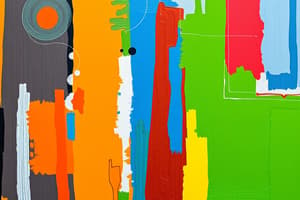Podcast
Questions and Answers
What is color theory?
What is color theory?
- The process of creating art using color
- The understanding of how colors affect mood and emotions
- The body of practical guidance for color mixing and the visual effects of a specific color combination (correct)
- The study of how light interacts with objects
Who were some of the first to discuss how colors can be produced by mixing other colors?
Who were some of the first to discuss how colors can be produced by mixing other colors?
- Leonardo da Vinci and Michelangelo
- Isaac Newton and Johannes Kepler
- Aristotle and Claudius Ptolemy (correct)
- Pablo Picasso and Vincent van Gogh
What are the three classifications of colors?
What are the three classifications of colors?
- Warm, cool, and neutral
- Light, medium, and dark
- Bright, dull, and muted
- Primary, secondary, and tertiary (correct)
What are tints and shades?
What are tints and shades?
What is the achromatic mixture of spectrally balanced red, green, and blue (RGB) when mixing colored light?
What is the achromatic mixture of spectrally balanced red, green, and blue (RGB) when mixing colored light?
What is the monochromatic formula?
What is the monochromatic formula?
What is color harmony?
What is color harmony?
What is the split-primary system?
What is the split-primary system?
What is the relevance of color theory?
What is the relevance of color theory?
Flashcards
Color Theory
Color Theory
A set of guidelines for mixing colors and understanding their visual effects.
Primary Colors
Primary Colors
Colors (red, yellow, blue) believed to be able to mix all other colors.
Secondary Colors
Secondary Colors
Colors made by mixing two primary colors.
Tertiary Colors
Tertiary Colors
Signup and view all the flashcards
Warm Colors
Warm Colors
Signup and view all the flashcards
Cool Colors
Cool Colors
Signup and view all the flashcards
Additive Color Mixing
Additive Color Mixing
Signup and view all the flashcards
Color Harmony
Color Harmony
Signup and view all the flashcards
Color Combination Schemes
Color Combination Schemes
Signup and view all the flashcards
Study Notes
Principles of Color in Visual Arts
-
Color theory is the body of practical guidance for color mixing and the visual effects of a specific color combination.
-
Aristotle and Claudius Ptolemy were some of the first to discuss how colors can be produced by mixing other colors.
-
The understanding of color theory dates to antiquity.
-
Colors are classified as primary, secondary, and tertiary.
-
Color terminology based on the color wheel and its geometry separates colors into primary color, secondary color, and tertiary color.
-
Traditional color theory was originally formulated in terms of three "primary" colors—red, yellow, and blue—because these colors were believed capable of mixing all other colors.
-
Warm colors are often said to be hues from red through yellow, browns, and tans included; cool colors are often said to be the hues from blue-green through blue violet, most grays included.
-
Any color that lacks strong chromatic content is said to be unsaturated, achromatic, near-neutral, or neutral.
-
Near neutrals include browns, tans, pastels, and darker colors.
-
Tints are created by mixing pure colors with white, while shades are created by mixing pure colors with black.
-
When mixing colored light, the achromatic mixture of spectrally balanced red, green, and blue (RGB) is always white, not gray or black.
-
It is not always the best practice to darken a paint color by adding black paint or lighten a color by adding white, as it can cause colors to shift in hue.Color Theory and Color Harmony
-
Additive and subtractive color models are used to describe how colors are created and mixed in different mediums.
-
The split-primary system is a color-wheel model that attempts to explain the unsatisfactory results when mixing traditional primary colors red, yellow, and blue. It suggests that the lack of chromatic intensity is due to chemical impurities or biases in the paints.
-
Color harmony is a complex notion that involves affective and cognitive responses to color, which are influenced by individual differences, cultural experiences, the prevailing context, intervening perceptual effects, and time.
-
Color theorists have devised formulae, principles, or guidelines for color combination, such as juxtapositions of complementary or analogous colors, split complementary color schemes, and triadic color schemes.
-
Color combination formulae and principles have limited practical application due to contextual, perceptual, and temporal factors.
-
Connotative color associations and color symbolism are culture-bound and may vary across different contexts and circumstances.
-
The monochromatic formula uses only one hue and creates variations by changing the value and saturation of the color.
-
Color theory has not developed an explicit explanation of how specific media affect color appearance.
-
Color theory is relevant in painting, visual arts, fashion, interior, and graphic design.
-
The split-primary system is still popular among contemporary painters, although it is based on false assumptions.
-
Color theorists have used color wheel models to define relationships between colors and to provide guidelines for color combination.
-
Color theorists have attempted to predict or specify positive aesthetic response or "color harmony" using formulae, principles, or guidelines for color combination.
Studying That Suits You
Use AI to generate personalized quizzes and flashcards to suit your learning preferences.




